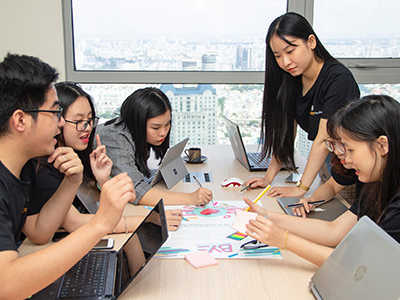Enhancing Teamwork
Social constructivist models suggest that students learn better if they construct their own knowledge by interacting with others. If you intend for your students to engage in collaborative work, please remember that it does not happen automatically. The conditions need to be created such that learners will want to work together. Johnson & Johnson (1999) suggested that the following five elements be implemented before effective collaborative work can take place:

1. Positive interdependence: Positive interdependence is the perception that we are linked with others in a way so that we cannot succeed unless they do. Their work benefits us, and our work benefits them. Within every cooperative lesson, positive interdependence must be established and strengthened. Strategies to do this include joint rewards (e.g., if all members of a group score 90% or better on a test, each will receive 5 bonus points); divided resources (e.g., giving each group member a part of the total information required to complete an assignment); and complementary roles (e.g., reader, checker, encourager, elaborator).
2. Individual accountability: The purpose of cooperative learning is to make each group member a stronger individual. To ensure that each member is strengthened, students are held individually accountable to do their share of the
work. Common ways to structure individual accountability include (a) giving an individual test to each student, (b) randomly selecting one student's product to represent the entire group, and (c) having each student explain what they have learned
to a classmate.
3. Face-to-face promotive interaction: Individuals promote each other's success by helping, supporting, encouraging, and praising each other's efforts to achieve. Certain cognitive activities and interpersonal dynamics only occur when students get involved in promoting each other's learning. These include orally explaining how to solve problems, discussing the nature of the concepts being learned, teaching one's knowledge to classmates, and connecting present with past learning. Accountability to peers, ability to influence each other's reasoning and conclusions, social modeling, social support, and interpersonal rewards all increase as the face-to-face interactions among group members increase. To obtain meaningful face-to-face interaction and discourage nonparticipation, the size of groups needs to be small (2–4 members).
4. Social skills: Students must be taught skills in leadership, decision-making, trust-building, communication, and conflict-management just as purposefully and precisely as academic skills. Placing socially unskilled individuals in a group and telling them to cooperate does not guarantee that they will be able to do so effectively. Procedures and strategies for teaching students social skills may be found in Johnson and F. Johnson (1999).
5. Group processing: Group processing exists when group members discuss how well they are achieving their goals and maintaining effective working relationships. Groups need to describe what member actions are helpful or unhelpful and make decisions about what behaviours to continue or change. When difficulties in relating to each other arise, students must engage in group processing to identify, define, and solve the problems they are having by working together effectively.
Carnegie Mellon University (2016). Eberly Centre for Teaching Excellence & Educational Innovation: Classroom Climate.
Cornell University (2012). Centre for Teaching Innovation: Classroom Climate.
University of Maryland (n.d.). Teaching and Learning Transformation Center.
Washington University in St. Louis. (2009). The Teaching Center.
Auster, C. J., & MacRone, M. (1994). The classroom as a negotiated social setting: An empirical study of the effects of faculty members' behavior on students' participation. Teaching Sociology, 22(4). 289-300.
Johnson, D. W., & Johnson, R. T. (1999). Making cooperative learning work. Theory into Practice, 38(2). 67-73. doi: 10.1080/00405849909543834
Race, P. (2009) In at the Deep End (2nd revised edition 2009). Leeds Met Press.
Rocca, K. A. (2010). Student participation in the college classroom: An extended multidisciplinary literature review. Communication Education, 59(2), 185-213.














/enri-thumbnails/careeropportunities1f0caf1c-a12d-479c-be7c-3c04e085c617.tmb-mega-menu.jpg?Culture=en&sfvrsn=d7261e3b_1)

/cradle-thumbnails/research-capabilities1516d0ba63aa44f0b4ee77a8c05263b2.tmb-mega-menu.jpg?Culture=en&sfvrsn=1bc94f8_1)

7e6fdc03-9018-4d08-9a98-8a21acbc37ba.tmb-mega-menu.jpg?Culture=en&sfvrsn=7deaf618_1)
